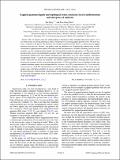Gapped quantum liquids and topological order, stochastic local transformations and emergence of unitarity
Author(s)
Zeng, Bei; Wen, Xiao-Gang
DownloadPhysRevB.91.125121.pdf (820.1Kb)
PUBLISHER_POLICY
Publisher Policy
Article is made available in accordance with the publisher's policy and may be subject to US copyright law. Please refer to the publisher's site for terms of use.
Terms of use
Metadata
Show full item recordAbstract
In this work, we present some new understanding of topological order, including three main aspects. (1) It was believed that classifying topological orders corresponds to classifying gapped quantum states. We show that such a statement is not precise. We introduce the concept of gapped quantum liquid as a special kind of gapped quantum states that can “dissolve” any product states on additional sites. Topologically ordered states actually correspond to gapped quantum liquids with stable ground-state degeneracy. Symmetry-breaking states for on-site symmetry are also gapped quantum liquids, but with unstable ground-state degeneracy. (2) We point out that the universality classes of generalized local unitary (gLU) transformations (without any symmetry) contain both topologically ordered states and symmetry-breaking states. This allows us to use a gLU invariant—topological entanglement entropy—to probe the symmetry-breaking properties hidden in the exact ground state of a finite system, which does not break any symmetry. This method can probe symmetry- breaking orders even without knowing the symmetry and the associated order parameters. (3) The universality classes of topological orders and symmetry-breaking orders can be distinguished by stochastic local (SL) transformations (i.e., local invertible transformations): small SL transformations can convert the symmetry-breaking classes to the trivial class of product states with finite probability of success, while the topological-order classes are stable against any small SL transformations, demonstrating a phenomenon of emergence of unitarity. This allows us to give a definition of long-range entanglement based on SL transformations, under which only topologically ordered states are long-range entangled.
Date issued
2015-03Department
Massachusetts Institute of Technology. Department of PhysicsJournal
Physical Review B
Publisher
American Physical Society
Citation
Zeng, Bei, and Xiao-Gang Wen. “Gapped Quantum Liquids and Topological Order, Stochastic Local Transformations and Emergence of Unitarity.” Phys. Rev. B 91, no. 12 (March 2015). © 2015 American Physical Society
Version: Final published version
ISSN
1098-0121
1550-235X